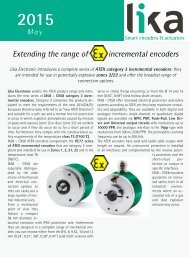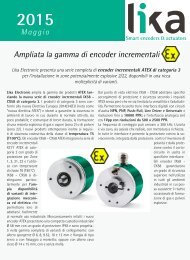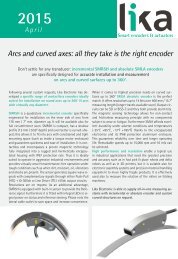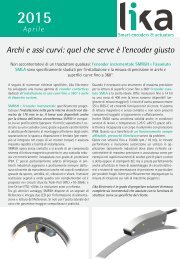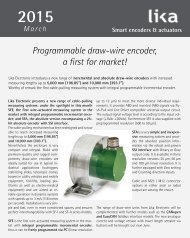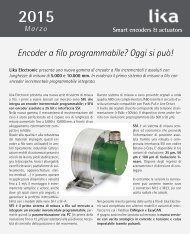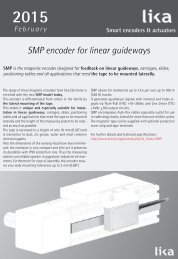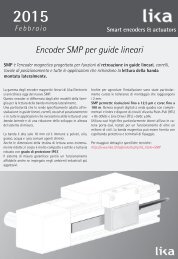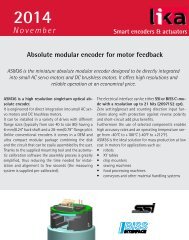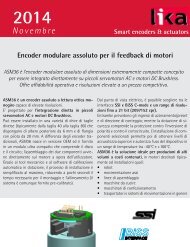LINEPULS & LINECOD catalogue 2016 in English
Lika Electronic incremental and absolute linear encoders catalogue 2016 in English Our new linear encoders catalogue is out now, and features many innovative new products and up-to-date information. The catalogue is expressly designed to set out the comprehensive range of incremental & absolute linear encoders from Lika Electronic. Check it out, it is completely renewed! Make sure you don’t miss out on a copy, download the pdf file from our web site or request your hard copy now! We have also got an interactive digital version in the works that shall be released soon!
Lika Electronic incremental and absolute linear encoders catalogue 2016 in English
Our new linear encoders catalogue is out now, and features many innovative new products and up-to-date information. The catalogue is expressly designed to set out the comprehensive range of incremental & absolute linear encoders from Lika Electronic. Check it out, it is completely renewed!
Make sure you don’t miss out on a copy, download the pdf file from our web site or request your hard copy now!
We have also got an interactive digital version in the works that shall be released soon!
Create successful ePaper yourself
Turn your PDF publications into a flip-book with our unique Google optimized e-Paper software.
<strong>LINEPULS</strong> • <strong>LINECOD</strong><br />
Technical <strong>in</strong>formation<br />
Mechanical and environmental <strong>in</strong>formation<br />
The accuracy of a l<strong>in</strong>ear encoder system largely depends also on mechanical alignment,<br />
thus the <strong>in</strong>stallers ability to ma<strong>in</strong>ta<strong>in</strong> all mount<strong>in</strong>g parameters with<strong>in</strong> the tolerance values<br />
specified <strong>in</strong> the technical documentation is vital for proper operation.<br />
As stated, a l<strong>in</strong>ear encoder basically consists of a sens<strong>in</strong>g head and a magnetic tape.<br />
One of these encoder assembly component parts is mounted on a fixed support while the<br />
other is secured to the mov<strong>in</strong>g structure of the application. In a customary <strong>in</strong>stallation, the<br />
magnetic tape is applied to a fixed support, while the sens<strong>in</strong>g head is fastened to the mov<strong>in</strong>g<br />
unit. But sometimes, for <strong>in</strong>stance <strong>in</strong> the measurement systems hav<strong>in</strong>g a rigid track profile<br />
such as SMIG and SMAG encoders, we could have the read<strong>in</strong>g head fastened to a fixed support<br />
while the magnetic tape is kept free to move.<br />
In both cases, the relation between the read<strong>in</strong>g head and the tape is critical and must be<br />
preserved along the whole axis travel. Thus, mount<strong>in</strong>g the two component parts parallel to<br />
the axis of travel for all planes with<strong>in</strong> specified tolerances will yield best results.<br />
Great care is required when mount<strong>in</strong>g a l<strong>in</strong>ear encoder because all the alignment dimensions<br />
can seriously affect the proper operation of the measur<strong>in</strong>g system.<br />
The Figure below shows the critical features that must be assessed and taken <strong>in</strong>to the<br />
greatest consideration dur<strong>in</strong>g <strong>in</strong>stallation.<br />
Make sure that the gap D between the sens<strong>in</strong>g head and the magnetic tape is always with<strong>in</strong><br />
the tolerance values <strong>in</strong>dicated <strong>in</strong> the specific documentation along the whole axis travel.<br />
The same considerations concern the gap you have to comply with when <strong>in</strong>stall<strong>in</strong>g the<br />
sens<strong>in</strong>g head and the external Reference magnet and/or the external limit switch magnets.<br />
Check the parallelism and planarity<br />
specifications for all the measur<strong>in</strong>g<br />
system component units:<br />
sens<strong>in</strong>g head, magnetic tape, reference<br />
external magnet, limit switch<br />
external magnets. Always comply<br />
with the tolerances concern<strong>in</strong>g roll,<br />
tilt, yaw and lateral deviation. Alignment<br />
specifications depend on<br />
the characteristics of each specific<br />
encoder model, so they are expressly<br />
provided with <strong>in</strong>stallation literature.<br />
Install the measurement system<br />
provid<strong>in</strong>g protection means aga<strong>in</strong>st<br />
waste, especially swarf as turn<strong>in</strong>gs,<br />
chips or fil<strong>in</strong>gs; should this not be<br />
possible, please make sure that<br />
adequate clean<strong>in</strong>g measures (as<br />
for <strong>in</strong>stance brushes, scrapers, jets<br />
of compressed air, etc.) are <strong>in</strong> place<br />
<strong>in</strong> order to prevent the read<strong>in</strong>g<br />
head and the magnetic tape from<br />
jamm<strong>in</strong>g. Optional rubber clean<strong>in</strong>g<br />
wipers can be supplied <strong>in</strong> specific<br />
models (see on page 15).<br />
The magnetic tape must be mounted evenly on the application surface ensur<strong>in</strong>g that it<br />
is perfectly levelled and free of bumps. The adhesion of the tape to the bond<strong>in</strong>g surface<br />
depends on a variety of factors such as the clean<strong>in</strong>g, the temperature at application, the<br />
roughness of the materials and the smoothness of the bond<strong>in</strong>g surface. To obta<strong>in</strong> optimum<br />
and safe adhesion, the bond<strong>in</strong>g surfaces must be well unified, clean and dry. The ideal application<br />
temperature range is +21°C to +38°C (+70°F to +100°F). Do not w<strong>in</strong>d the tape with<br />
the magnetized side fac<strong>in</strong>g outwards. Do not twist or bend the magnetic tape.<br />
For the recommended tape length <strong>in</strong> relation to the travel to be measured please see the<br />
section “Tape dimensions“ on page 12.<br />
Both the magnetic sensor and the tape are sensitive to magnetic fields and may be damaged<br />
even permanently if exposed to a powerful magnetic field generated by magnetic tools<br />
or l<strong>in</strong>ear motors. Please use precautionary procedures dur<strong>in</strong>g <strong>in</strong>stallation <strong>in</strong> order to avoid<br />
performance degradation or loss of functionality. Always keep the measur<strong>in</strong>g system a safe<br />
distance from devices produc<strong>in</strong>g strong magnetic fields.<br />
16




